By James Zug
Last issue we reviewed a single book, 555, about Jahangir Khan; this issue we take on seven books ranging from novels to anthologies to coaching manuals.
The Science of Sport: Squash
By Stafford Murray, with Mike Hughes, Nic James and Goran Vuckovic
Ramsbury, England: Crowood Press, 2016
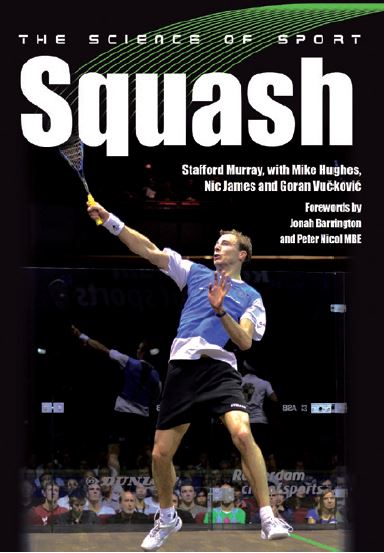 In the late 1990s Stafford Murray became known as more or less the sabremetrician of squash. He led the development of performance analysis and statistical systems for England Squash.
In the late 1990s Stafford Murray became known as more or less the sabremetrician of squash. He led the development of performance analysis and statistical systems for England Squash.
Peter Nicol used Murray’s work to change his technique between the semis and finals of the 2006 Commonwealth Games; James Willstrop used it to analyze his Egyptian opponents during his 2010 Tournament of Champions run where he took down Amr Shabana, Karim Darwish and Ramy Ashour in a row.
No light reading here. The Science of Sport is a valuable place to go if you would like your squash studies digested for you (it turns out that squash has been the subject of many dozens of peer-reviewed journal articles). Terms get batted around: the Fick Equation, the Schmidt Schema Theory and zones of passive inadequacy (don’t worry, it is a term for flexibility, not something wrong in your marriage).
It is an uneven book. There are not one but two forewords (by Jonah Barrington and Peter Nicol). The eleven chapters, each different authors, vary in tone and style. But it is jammed with provocative ideas. There is a detailed description of Nick Matthew’s unbelievable recovery from knee surgery before the 2014 Commonwealth Games—he used an anti-gravity treadmill among other devices. And there are interesting reports on scoring: a 1994 study on whether rallies are longer using point-per-rally scoring or hand-in, hand-out scoring (they aren’t) and a 2009 study on the switch from fifteen to eleven-point games (match times are about the same, players are hitting more dropshots and there are more critical points).
A short to-do list that science says is good for us: ice baths, pasta, stretching, creatine supplements, napping, cherries. Cherries? They mention one study that said consuming forty-five Bing sweet cherries a day reduced inflammation. Another reason not to chop down that cherry tree.
Allegiance
By Kermit Roosevelt
New York: Regan Arts, 2015
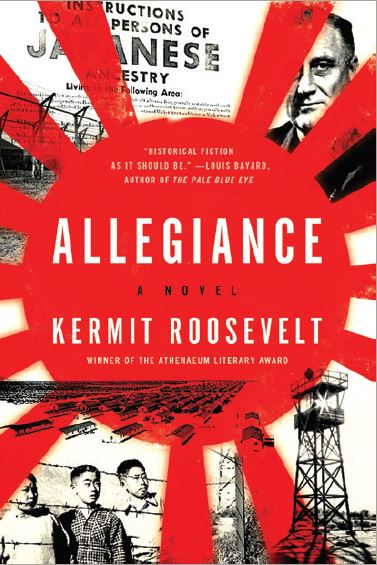 A gripping novel set in Washington during the Second World War, Allegiance follows a Supreme Court clerk who uncovers conspiracies that relate to the interment of Japanese-Americans and insider stock trading.
A gripping novel set in Washington during the Second World War, Allegiance follows a Supreme Court clerk who uncovers conspiracies that relate to the interment of Japanese-Americans and insider stock trading.
Roosevelt, class of 1993 at Harvard and now a law professor at Penn, often drops in references to squash. Cash Harrison, the protagonist, grew up playing at Merion Cricket Club—“his grip on the racquet like an honest handshake.” His game, however, was like his name: “very reliable but doesn’t draw much interest.”
A couple of times, Harrison and a colleague play at the Metropolitan Club in Washington. They both have “the Merion backswing” and his friend smacks the ball like “Beekman Pool”. “You can walk past a court and know that Harvard players are warming up by the sound alone.” A contentious post-match discussion leads to Harrison snapping his partner’s racquet in two across his knee.
Near the end, as the story is reaching a sad but realistic denouement, Roosevelt lifts something I lifted from Jack Barnaby. Harrison says what his college coach [an unnamed Harry Cowles] told him when asked about when do you give up: when you’re dead.
Balls to the Wall: A Compilation of Squashed Stories
By Alan Stapleton
Privately printed, 2016
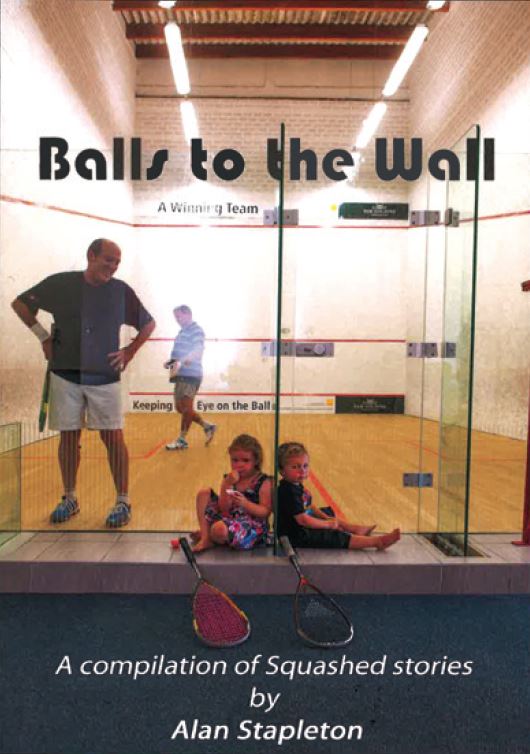 Alan Stapleton got hooked on squash in the early 1970s when Jonah Barrington came to King William’s Town in the Eastern Cape of South Africa to give two clinics. Since then, he’s been a player, coach (he led South Africa’s squad to the World Juniors in 1996 and attends international coaching conferences), administrator (he helps run an urban squash program) and columnist for a tabloid in Port Elizabeth.
Alan Stapleton got hooked on squash in the early 1970s when Jonah Barrington came to King William’s Town in the Eastern Cape of South Africa to give two clinics. Since then, he’s been a player, coach (he led South Africa’s squad to the World Juniors in 1996 and attends international coaching conferences), administrator (he helps run an urban squash program) and columnist for a tabloid in Port Elizabeth.
Despite the unfortunate title, Balls to the Wall is a passionate and witty anthology. He describes playing one friend more than 500 times, 98% of them going to five games. He dispenses good advice: for juniors, such as how to avoid the perils in the boast-drive drill; for league players (don’t skip out after your match); and for coaches, such as not saying “pink elephants” in between games (“don’t say ‘don’t’”).
His best might be the column where he imagines the styles various South African politicians might have had if they played squash. Mandela would have had a “teasing, diplomatic game” while Bishop Tutu would have been a “hustle-bustle, busy-busy-bite-at-your-heels opponent.”
Mental Strength: Your Guide to Success in Sports
By Patrick Hartunian
Toronto: Meraki House, 2016
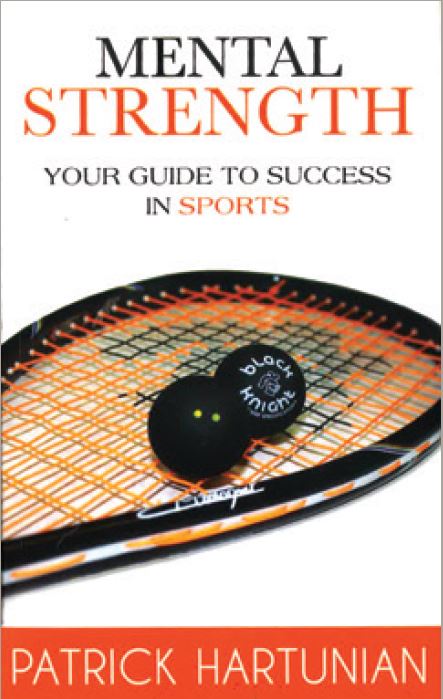 A squash pro at a Life Time Fitness club in Ontario and formerly at Toronto Cricket and Mayfair, Hartunian has produced a small manual for squash juniors. He writes about positive reinforcement, breathing, game plans, goal setting and mental clarity. He deploys ideas from Gandhi to Lombardi to Einstein to Tom Cruise in The Last Samurai. Hartunian has a number of interesting theories, including working first on offensive shots from defensive positions to train your mind early on to hit the better, harder shots.
A squash pro at a Life Time Fitness club in Ontario and formerly at Toronto Cricket and Mayfair, Hartunian has produced a small manual for squash juniors. He writes about positive reinforcement, breathing, game plans, goal setting and mental clarity. He deploys ideas from Gandhi to Lombardi to Einstein to Tom Cruise in The Last Samurai. Hartunian has a number of interesting theories, including working first on offensive shots from defensive positions to train your mind early on to hit the better, harder shots.
Casino De France
By Graham Tempest
Apopka, Fla: Brightway Publishing, 2016
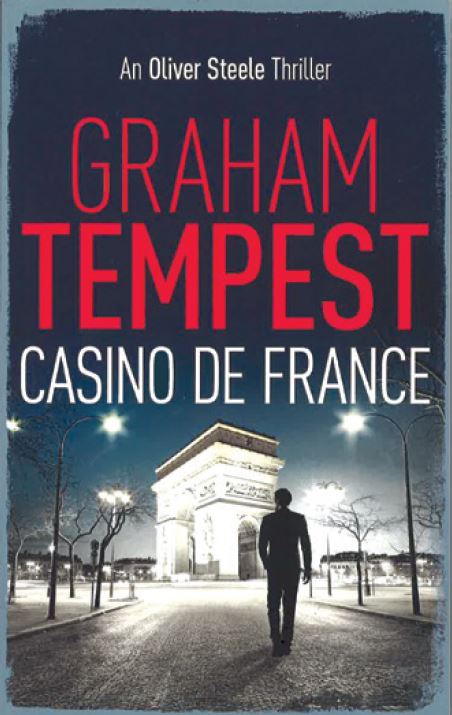 The fourth Oliver Stone thriller by Tempest (the pen name of longtime squash player and administrator Jeremy Stone) Casino De France is the most headline-ripping, tense and focused of the series. Stone is trying to stop a terrorist who is plotting to detonate a nuclear bomb in Paris.
The fourth Oliver Stone thriller by Tempest (the pen name of longtime squash player and administrator Jeremy Stone) Casino De France is the most headline-ripping, tense and focused of the series. Stone is trying to stop a terrorist who is plotting to detonate a nuclear bomb in Paris.
Squash? Plenty. Stone splits four games with a mysterious stranger who happens to walk by at a club in Montparnasse. Greg Stiles, a Southern California legend, plays in the semis of the club championship against a Pakistani physicist. Stiles, wearing braces on both knees, comes back from a 2-0 deficit to win in five, finishing off the match with a three-wall nick. Rosie, an African woman based in Los Angeles “with a smile to melt icebergs,” plays at the old South Bay Squash Club in Torrance and enjoys the co-ed sauna there, reachable only through the men’s locker room.
My favorite squash bit was the code the terrorists used. “Squash”—as in, “What about a game of squash?” meant things were going according to plan; “racquetball” meant things had gone awry.
Ships, Swinders and Scalded Hogs: The Rise and Fall of the Crooker Shipyard in Bath, Maine
By Frederic B. Hill
Lanham, MD: Down East Books, 2016
The Life of Kings: The Baltimore Sun and the Golden Age of the American Newspaper
Edited by Frederic B. Hill and Stephen Broening
Lanham, MD: Rowman & Littlefield, 2016
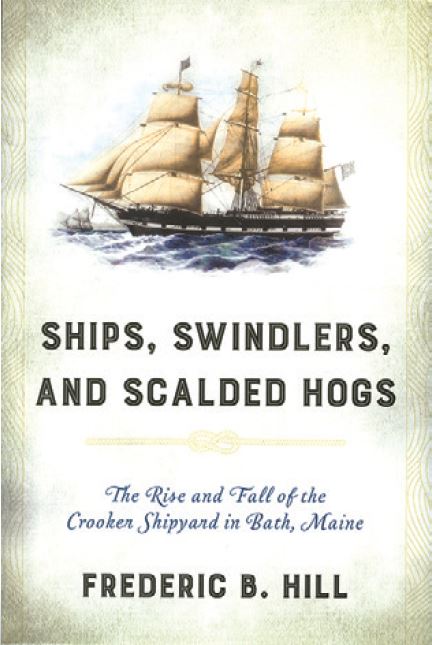 Fred Hill is the founder of the M4—the Maine/Maryland at Meadow Mill doubles tournament held since 2009. He plays both in Baltimore and in Portland.
Fred Hill is the founder of the M4—the Maine/Maryland at Meadow Mill doubles tournament held since 2009. He plays both in Baltimore and in Portland.
His well-researched biography of the Crooker brothers is a labor of love: one of them was his great-great-grandfather. After a mid-nineteenth century boom, the Crooker brothers had an acrimonious falling-out, the shipyard closed and one went to jail and died almost penniless. But Hill’s story is filled with proof that the past is another country, with terms like bottomry bonds (a maritime lien) and demurrage (a fee when a ship was slow to load or unload).
Of more general interest might be the brilliant Life of Kings. Hill was a reporter and foreign correspondent at the Sun from 1965 to 1985, and he helped compile this fascinating anthology of essays about the grand Baltimore daily. Many all-time legends contributed: Russell Baker who started at the Sun in 1947 and later wrote the classic memoir Growing Up; Kevin Kallaugher, the famous KAL political cartoonist; Laura Lippman, the novelist (see: Every Secret Thing); Scott Shane, the New York Times national security reporter; and David Simon (see: HBO’s The Wire).
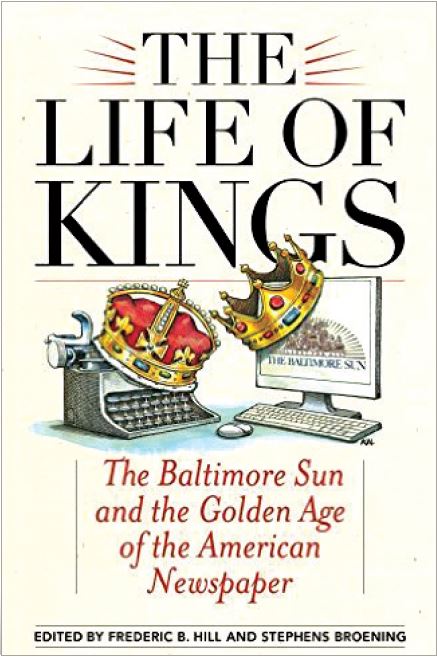 Nostalgia hangs heavily if invitingly. Local investigations eventually derailed major leaders. Reporters rushed to meet double-dot deadlines (the third edition’s deadline) or dined on terrapin stew at the Maryland Club. At one point the Sun boasted nine overseas bureaus (about a third of the essays richly touch on life as a foreign correspondent). It is not all golden. Writers do point out the inherent sexism and racism at the Sun (most directly by Antero Pietila, a Finnish journalist).
Nostalgia hangs heavily if invitingly. Local investigations eventually derailed major leaders. Reporters rushed to meet double-dot deadlines (the third edition’s deadline) or dined on terrapin stew at the Maryland Club. At one point the Sun boasted nine overseas bureaus (about a third of the essays richly touch on life as a foreign correspondent). It is not all golden. Writers do point out the inherent sexism and racism at the Sun (most directly by Antero Pietila, a Finnish journalist).
In 1986 the Sun was sold to a newspaper conglomerate, and fourteen years later to Chicago Tribune group and, like most newspapers, it is now a shell of its former self. Eighty percent of its 1986 newsroom is gone.





